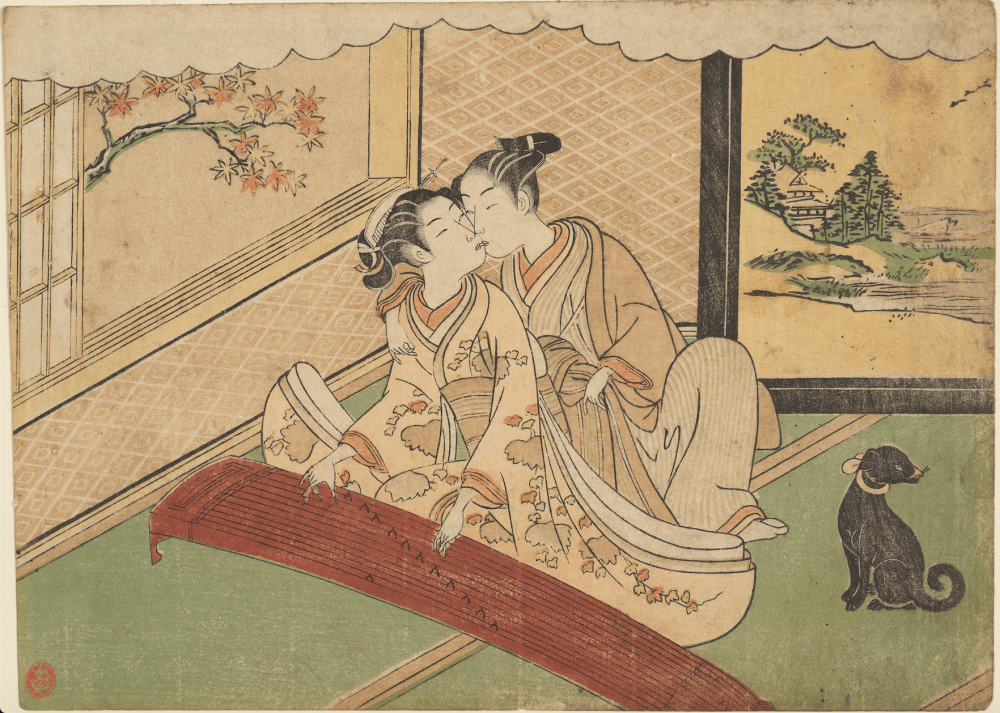A new exhibition reveals surprisingly queer gender and sex roles in Edo-period Japan.
When you think of Japan you may think of a formal society bound by strict gender binarism, hierarchical codes, and a suppression of female sexuality. That’s only partly true. In Japan during the Edo period (1603-1868), gender roles and sexual relations were more flexible and openly enjoyed than history has us believe. And of course, it is the surviving art that pulls back the curtain on some enlightening and erotic Japanese customs and pursuits, which are of particular interest to the LGBTQI community.
The new exhibition, A Third Gender: Beautiful Youths in Japanese Prints, now showing in New York, is the first exhibition in the United States to demonstrate, through a collection of beautiful and valuable woodblock prints, books, and lovely objects, that in Edo society, homo-eroticism, androgyny, gender ambiguity, and bisexuality flourished and were encouraged.
The wakashu, or non-masculine adolescent boy, was an object of desire for both women and men until he reached manhood, after which he too could have relations with wakashu. It was a social convention similar to male roles in Ancient Greece, but with the difference that women, too, actively enjoyed wakashu who functioned as a third gender.
Plus, wakashu could actively pursue women too for sexual trysts, which indicates that sexuality in Japan’s Edo period was not strictly monogamous or procreative, but more libidinal. These young men cultivated a feminine appearance; homo-eroticism for both sexes was appreciated and enjoyed.
The gender-ambiguous wakashu passed into art and literature as a recognizable type, and went on to influence male and female cross-dressing traditions, such as in the theater style of kabuki, the cross-dressing haori-geisha, whose specialty was to act as dominant or more masculine hostesses, and the all-female, male impersonators of today’s Takarazuka revue.
Currently showing at New York’s Japan Society Gallery, which is close to the United Nations Plaza, A Third Gender is a beautifully curated exhibition some of which is explicit and not for kids. These artistic prints, which depict wakashu pursuing leisure or in scenes of seduction, were very popular in their day as interior decoration and as shunga or erotica.
In fact sex was a widely-pursued past-time, with designated yūkaku or pleasure precincts for all genders and gender expressions.
But what about lesbians, you may ask. Were there any lesbians in Edo-period Japan? The answer is more than likely yes. If not same-sex attracted women who identified exclusively as lesbian, we do know that lesbian sex was represented and depicted, and that sexual relations between women were probably expected, especially within such a strongly homo-social culture.
Additionally, Taoism as a philosophy and theology encouraged an active sex life, or the “bedroom arts” as a healthy aspect of living, and as a way of joining and releasing energy and stress.
Pay attention until the end of this exhibition and, in addition to the general gender fluidity (not to mention a male-female-female threesome), you will see a color woodblock print of two women—dildo and all—in arguably the collection’s most startlingly erotic item.
A Third Gender: Beautiful Youths in Japanese Prints, Japan Society Gallery, March 10—June 11, 2017.
333 East 47th Street, New York N.Y. 10017
